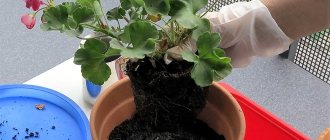In this article we will consider issues regarding the care and planting of gladioli.
Surely, many of us know what a beautiful flower looks like – gladiolus. Speechweed, as this crop is also called, really cannot help but attract flower growers with its lush color and variety of species.
However, not all gardeners and gardeners are in a hurry to plant these plants on their plots, because they believe that caring for them requires a lot of effort. Whether this is true or not, today we will try to figure it out.
When to prepare gladioli for planting in the spring, take them out of the refrigerator for germination: timing
Gladioli cannot be called too picky flowers, however, they, of course, need some care.
Let's start, perhaps, with preparing flowers for planting in spring:
- First you need to remove the gladioli from their storage place - the refrigerator. This should be done about a month before planting in the ground.
- Next, you should look at the condition of the corms. Be sure to clean them of scales. This must be done extremely carefully, as the eyes of the plants can be damaged. Then we take brilliant green and treat all the “wounds” of the crop with it.
- After this, you can move on to the next job. If you have corms that have formed a pair of eyes, you can divide them. They do this, of course, very carefully, and the damaged area is necessarily treated with either ash or activated carbon in tablets, which must first be crushed.
- Further, if desired, you can sort the flowers according to different criteria: variety, size, age.
Preparing the bulbs
- All corms that are unsuitable in your opinion need to be selected and eliminated. Dry, rotten, blackened corms are definitely not suitable for planting.
- Now we carefully put the gladioli in a box or box and send them to a fairly bright place, but without direct rays of the sun. It is better to use a box made of cardboard.
- When laying corms, pay attention to their position. The eyes should not be pressed against anything, otherwise they will grow crookedly. Each bulb should take its place and not lie on top of another.
- That's all, the gladioli are prepared for further planting. Now you need to wait for the right time and temperature and start planting flowers.
Useful tips from experienced flower growers
Experienced gardeners who have been growing gladioli for many years are ready to share some tricks:
- Remove the bulbs about 30 days before planting and place them in a well-ventilated location that is protected from direct sunlight. At the same time, there is no need to plant them in sawdust or soil.
- Try to purchase gladioli bulbs from trusted sellers or collectors. It is better not to buy Dutch bulbs in hypermarkets, as they are stuffed with chemicals, and the bushes grown from them quickly lose their spectacular appearance.
- If any disease has affected the gladioli bushes on the site, then these flowers can be planted here no earlier than four years later.
- Many gardeners believe that the sooner they can plant bulbs in open ground, the better. In this case, it is recommended to plant injured specimens first; in this case, they will have time to grow a replacement bulb.
- If there are many bulbs of the same variety, then they can be planted several days apart, for example, on May 2, 8, 11 and 16. In this case, flowering will last longer.
- Bulbs should not be deeply buried in the soil, nor should they be planted too close to the surface of the earth. In the first case, they may not bloom, and in the second, the bush will collapse.
What soil is needed for gladioli, what kind of soil do gladioli like?
Particular attention should be paid to the soil in which the flowers will be planted, because if it is chosen incorrectly, the crop will not take root and, accordingly, will not bloom.
- This crop responds well to black soil, which is rich in humus. It is also suitable for light loamy and sandy soils.
- The acidity of the soil in which gladioli will be planted should be neutral or weak.
Soil for flowers
- If the soil is not suitable, most often it is improved, and only then flowers are planted in it.
- If the soil is heavy clayey, it is worth adding weathered peat, if the soil is sand - humus.
How to prepare, divide, clean and what to soak gladioli bulbs in before germination?
Having taken the flower bulbs out of the cool place in which they were stored, you need to immediately start processing them.
- Earlier we talked about the fact that all corms must be cleared of scales. It is necessary to do this, because various parasites and pests can live in them. To clean the children, you need to take them in your hands, lightly press the film, and then pry it with your fingernail and remove it. Clean them immediately before planting.
- It is not at all necessary to divide the bulbs, but almost all gardeners do this. To do this, you need to take the onion that has 2 growth buds and divide it into 2 parts. Treat the cut area with ash or coal.
Before planting, it is important to prepare the bulbs
- An important step in preparing gladioli is soaking them. To do this, you need to place all the bulbs in garlic infusion. Prepare the infusion as follows: peel and grate 270 g of garlic, then pour 10 liters of water into the vegetable. We place not only adult bulbs in this liquid, but also children, and wait a couple of hours. Garlic disinfects gladioli and affects various pests.
- If the option with garlic does not suit you for some reason, use solutions of potassium permanganate and karbofos. First you need to carry out the procedure with a solution of potassium permanganate. To do this, dissolve 1 g of the product in 10 liters of water and dip the onions in the resulting liquid for half an hour. Afterwards, dissolve 25 g of karbofos in 10 liters of water, and put the plants in this solution for half an hour.
- After all such manipulations, you can treat the crop with means that will accelerate its growth. To do this, add 1 tablet of heteroauxin, 1 g of sodium humate and 1 g of succinic acid to 10 liters of water. Plants must spend at least 8 hours in this liquid.
Diseases and pests
Being corms, gladioli are susceptible to the same diseases and pests as potatoes or garlic. Among them:
- various viruses
- fungus that attacks tubers and leaves: fusarium, botrytis, gray rot
- mycoplasma, bacteria
- ticks
- thrips
- caterpillars and aphids
Lush flowering of gladioli.
Photo from pixabay.com Read about how to preserve the natural beauty of flowers here.
Gladioli sprouted in January, February, March: what to do?
Due to improper storage, the bulbs of this crop often germinate before the required time.
- The thing is that gladioli, during their forced rest, go through 2 stages: the first stage is the time during which the flowers are at rest for reasons beyond our control, the second stage is the time during which we provide peace to the culture, creating certain conditions for her
- By conditions we mean air temperature of about +10 degrees and humidity no more than 70%
When the storage conditions of the crop are violated, we get flowers that sprouted in winter. In this case, the algorithm of actions should be as follows:
- We carefully transfer all the corms to a drier place. This place should be warm enough. In a few weeks the plants will dry out properly.
- After this, we take the corms and transfer them to a place where the air temperature will not exceed +6 degrees. The humidity in this room should be lower than normal.
- A couple of weeks before planting gladioli, they need to be moved to a room with a temperature of about +15 degrees. Such conditions will contribute to the awakening of culture.
It is not recommended to plant prematurely sprouted flowers in the ground, since they, in principle, will not yet be able to take root and grow normally.
Brief description of cultivation
The flowering period depends on the variety. It may begin during the first weeks of summer or later. Some representatives of this plant can bloom even in early autumn. It is recommended to plant the flower in the spring, and remove the bulbs from the ground in the fall (September-October). They must be stored in a room whose temperature is 5-10°C.
For good development of gladiolus, it is necessary to select a site with good bright lighting and soil with low acidity (6.5-6.8 pH). Gardeners plant the flower in a place with structural black soil, light loam or sandy loam.
Gladioli flowers need generous weekly watering with 10-12 liters of liquid per 1m2. For fertilizers, compositions of mineral origin with a liquid consistency and organic mixtures are used. The procedures must be performed three times per season. The first time is recommended to be carried out when 1-2 leaves are formed, the second - during the formation of 5-6 leaves, and the third - until the buds develop.
Gladioli can be propagated by seeds, tubers and buds.
Problems that may arise while growing flowers include diseases and insect damage. For example, a plant may develop fusarium, curvularia, gray mold, bacterial scab, cancer, smut, septoria, penicillosis or sclerotinia. In addition, the flower can be damaged by slugs, cabbage cutworms, thrips, meadow mites, wireworms and mole crickets.
What to do if a gladiolus sprout breaks?
Very often we order new varieties of crops from various online stores. At the same time, the transportation of flowers often leaves little to be desired. And in everyday life it happens that the sprouts of culture break. If this happens to you, it is important to know the following information.
- Most often, good healthy bulbs have so-called spare buds
- If you create conditions that are comfortable for the plant, it will survive and after planting it will definitely delight your eye with lush flowering
- If there is still a lot of time before planting in the ground, place the onion with the broken sprout in a fairly cold and, most importantly, dry place
- If you need to plant the crop very soon, then the bulb with the broken sprout should be left in a warm, bright place. This is necessary so that the spare kidneys begin to wake up faster
In any case, do not rush to throw away the plant, try all available methods and only then make a decision.
GROW THE MOST BEAUTIFUL GLADIOLUS!
If you want to grow gladioli in your garden, choose the most beautiful varieties! We want to offer you the best from our collection! Mystical Amber, Indian Summer, Boniface, Burgundy, Evergreen, Vine, Gaidan, Deep Red, Terrible, Jester, Ding-Don, Zizani, Zorro, Kirov, Color, Contrast, Corazon, Cote D, Azur, Kum Laude, Moscow, Princess Margarita, Purple, Murmansk, Omsk, Provence, Ram Bam, Robert, Pink lace, Rus', Saratov, Sugar Plum, Ufa, Flora, Tsepky.
We also have wonderful mixes of different varieties of gladioli, skillfully selected by our designers according to color scheme. These are the sets: Butterflies, Marshmallows, Lemon in chocolate, Terry.
Even a novice gardener can grow gladioli. But how much joy and aesthetic pleasure they will give you and your loved ones with their long, lush flowering. And I will also save you from any trouble!
Time to plant gladioli in open ground in spring: month, air temperature
In order to choose the right time and month for planting a crop, it is recommended to pay attention to the weather outside the window.
Most often, nature itself tells flower growers when it is time to plant plants.
- If the spring is early and warm enough, gladioli bulbs can be planted at the beginning or end of April.
- If spring is not as warm as we would like, then planting should be postponed until the beginning of May, or even its first week.
Planting bulbs
- You can navigate by folk tips. If small leaves begin to form on the birch tree, this is a sure sign that the bulbs can be planted.
- You also need to focus on the soil temperature. The most suitable soil is considered to be one that has warmed up to +10 degrees. The depth of the soil being tested is about 12 cm.
Optimal landing times
It is best to start preparing the soil for planting gladioli in the fall by testing the soil for acidity: the optimal indicator recommended for bulbs is a slightly acidic environment within the pH range of 5.5-6.5. During the same period, fertilizers with a high content of phosphorus and potassium are added to the soil.
But the bulbs should be planted when the threat of spring frosts has passed. In Russian realities, this period begins at the end of April-beginning of May. At this time, the soil contains the optimal amount of moisture suitable for gladioli bulbs, so it is important not to miss this moment.
Preparation and treatment of gladioli bulbs against thrips before planting in spring: means, description
Thrips are special enemies of flower growers, as they cause considerable harm to many crops.
To save gladioli from these pests, use these methods.
- Before planting, you need to take the plants and place them in fairly hot water - 50°C. You can keep gladioli in such water for no more than 3-5 minutes.
- You can also treat the culture in Actellik solution. This product has a complex effect on all parts of the plant, destroying many pests. At the same time, the product is safe for flowers and can be used with other drugs. To prepare the required solution, take 10 liters of water and dilute 15 g of the product in it.
Bulb processing
- You can use a folk remedy, which, according to flower growers, is no less effective than special means. We take 800 g of garlic, peel it, pass it through a press, collecting the juice. Dilute the resulting juice with 10 liters of water. Dip the plants in this solution for 1 hour before planting.
- It is also recommended to disinfect the crop bulbs with karbofos. Take 10 liters of water and dissolve approximately 50 g of the product in it. Immerse the plants in the solution for 5 minutes. The procedure must be done immediately before landing.
- A good remedy is Inta-Vir. To use it, dissolve 1 tablet of the substance in 10 liters of water. Place the plants in the resulting liquid for 5 minutes. After the procedure, we immediately plant the crop.
Caring for flowers after planting
In order for gladioli to grow normally and bloom luxuriantly, they will need good care, which includes watering, weeding, fertilizing, tying and processing.
Watering
Gladioli are watered once every 2 days, and during dry periods - daily in the evening.
For 1 square meter of bed, take from 8 to 10 liters of water, which should be settled and warm. When watering, it is recommended to pour water between the rows, and not on the bulbs, as this can cause them to begin to rot. During periods of prolonged rain, watering is reduced to twice every 7 days or the flowers are not watered at all.
Please note that every time after watering or rain, be sure to loosen the soil surface, which will ensure free access of air to the roots. While loosening, remove all weeds from the area.
Fertilizer
During the season, flowers need to be fed 4 times:
- When the length of the sprouts is 10 centimeters, the bushes around are covered with a layer of humus. This will prevent overheating of the soil and also reduce the number of waterings.
- During the formation of three leaf blades, plants are fed with ammonium sulfate or urea (2 tablespoons of substance per 1 square meter of plot).
- Next, carry out 2 feedings of gladioli with phosphorus-potassium fertilizer. The first feeding is when 5 or 6 leaves appear, and the second is when the buds are laid.
Treatment
Throughout the season, 3 preventive treatments are carried out on gladioli against diseases and pests; a special solution is used for this. To prepare it, take a liter of water in which 0.15 grams of boric acid or the same amount of potassium manganese is dissolved. Instead, you can use a solution of Bordeaux mixture (2 grams per bucket of water).
The first treatment is carried out during the preparation of the bulbs for planting, the second - after the formation of arrows and the third - during the formation of buds.
Garter
Tall varieties of gladioli, whose stems are more than one and a half meters long, need a garter. To do this, you can install a separate peg next to each bush, or you can stretch a wire along the plants and tie the stems to it. Do not forget to hill the stems of such bushes, this will make them more stable.
Proper planting of gladioli in the spring so that they bloom well and do not fall: depth, planting rules
Planting of this crop begins when the soil warms up to at least +10 degrees at a depth of 10 cm.
Most often, the planting period falls at the end of April, beginning of May. In order for the planting of flowers to be successful, and the gladioli to please you with their flowering, it is recommended to adhere to the following rules when carrying out this process:
- Plant the healthiest, highest quality plant bulbs first.
- Gladioli are planted in sandy soil, because such soil has a beneficial effect on plant bulbs and performs a protective function.
- To achieve a similar effect, proceed as follows: pour a little sand into the holes dug for the bulbs. It will be enough to fill each hole with a layer of sand of 1.5 cm.
- An already planted plant is also lightly sprinkled with sand, and then with soil.
Planting in spring
- When planting plants, keep an eye on the distance between them. If the bulbs of the crop are large enough, then the distance between them should not be less than 15 cm, between the rows of such plants the distance should be at least 20-25 cm. If you are planting children, then it will be enough to make the distance between each bulb 5 cm, and between rows – 15 cm.
- The depth at which plants need to be planted also depends on the soil and their size. If the crop is planted in chernozem or sandy soil, then the depth should be approximately 15 cm, but if the soil is clayey, then it will be enough to plant the bulb to a depth of 8 cm. On average, corms are planted to a depth of 12 cm. Children are planted to a depth of 4 cm.
- Before planting plants, be sure to moisten the soil. However, do not turn the hole into a small swamp.
How to plant
Now let's move on to how to plant gladioli. Just before planting the bulbs, the beds prepared for them are dug up, the necessary fertilizers are added to the soil (no cow manure - only phosphorus and potassium fertilizers, remember the level of soil acidity!). Small holes are dug in the beds to suit the size of the corms; the recommended distance between each hole is 25-35 cm from each other.
The bottom of the holes is covered with sand to protect the tubers from diseases, and the children from direct contact with the soil. Afterwards, the holes already filled with bulbs are again covered with a layer of sand and then soil.
A CONVENIENT METHOD FOR PLANTING GLADIOLUS. Video
How often to water gladioli?
This crop loves water, so plants must be watered properly. Otherwise, the root system of plants may be damaged, and this in turn will affect the development of flowers.
- Watering is carried out exclusively with warm water. Cold or even cool water is not suitable for watering this crop.
- Gladioli do not need frequent watering, however, there is no need to skimp on water when watering the plants. The soil should be moistened to at least 25 cm in depth, or even to the full 30 cm.
- For each plant you need to use about 10 liters of water.
- The amount of water used also depends on weather conditions. If the weather is hot outside, the amount of water can be increased by 1.5 times.
- After the procedure, it is recommended to lightly weed the soil and loosen it.
Can gladioli withstand spring frosts?
It should immediately be noted that gladioli are heat-loving crops, so temperature fluctuations have an adverse effect on plants.
- It is generally accepted that air temperatures from +17 to + 25°C are most suitable for the normal growth and development of this crop.
- It is also important to consider that nighttime cold snaps have a much greater effect on plants than daytime ones.
- Plant roots feel good at a soil temperature of +10°C.
- During the growing season, the crop may suffer if the air temperature drops to -4°C.
- Spring frosts are dangerous for gladioli. If the plant stays for about 8 hours. at a temperature of -5°C, its leaves will suffer, however, not critically. If the temperature drops to -7°C, then during the same time the flowers will die.
- In order for plants to tolerate frost as best as possible, they need to be hardened off in a timely manner. This procedure will significantly reduce the risk that gladioli will not survive spring frosts.
How to feed gladioli when planting, in spring, during flowering: fertilizers, folk remedies
Fertilizing plants plays a huge role, because in this way the flowers receive all the microelements and substances they lack.
- Initially, fertilize the soil in which gladioli will be planted. To do this, urea, ash, potassium sulfate and superphosphate are added to the soil. For example, you need to take approximately 45 g of ash per 1 m2, if the choice fell on urea, then 30 g will be enough, potassium sulfate is used in an amount of 20 g, and superphosphate - 30 g
- Next, the plants themselves are fed. As soon as the second leaves appear on the crop, you can fertilize it with chicken droppings. To do this, prepare a solution based on a ratio of 1:20. Also, the first fertilizing can be done using nitrophoska. To do this, dilute 50 g of the product in 10 liters of water. Leave this liquid for a day, and then fertilize the plants with it.
Next, we will feed the gladioli when 5 true leaves appear on them. For this fertilizing, add the following components to the soil per 1 m²:
- Ammonium sulfate – 15 g
- Superphosphate – 15 g
- Potassium sulfate – 15 g
Feeding
As soon as a peduncle appears on the plant, it is time to make the next feeding. For this stage, it is recommended to take the following substances per 1 m²:
- Urea – 7 g
- Superphosphate – 30 g
- Potassium sulfate – 25 g
- Final fertilizing is carried out after the crop has flowered. It is appropriate to water the flowers with a solution of wood ash. To do this, dilute 1 glass of the substance in 10 liters of water.
Before buds begin to form on the plants, it is recommended to spray. To do this, mix the following substances:
- Boric acid – 1.5 g
- Copper sulfate – 2 g
- Cobalt nitrate – 1.5 g
- Zinc sulfate – 1 g
- Liquid soap – 15 g
- Water – 10 l
We spray the flowers with this solution so that the liquid gets onto the entire plant. For the procedure, choose the evening time.
How to care
Caring for gladioli is not the most difficult task, but there are recommendations that should be followed so that the plant does not wither.
Watering
Gladioli love water!
If your area receives less than an inch of rain per week, water your gladioli regularly throughout the summer. How to care for gladioli if there is enough rainfall? In this case, water them moderately so that the soil remains moist throughout their growth (about 10 liters of water per 1 m2) - the main thing is to prevent the soil from becoming waterlogged. To do this, you can dig grooves between the ridges and pour water into them.
Top dressing
There is no simplified feeding scheme for gladioli, since at each stage of development the plant requires certain nutrients that ensure healthy growth.
The first feeding is carried out at the stage of appearance of the first 2-3 leaves of gladiolus. At this time, gladioli most require nitrogen fertilizers, which are applied in a standard dose.
By the stage of the second feeding, which occurs when the plant has 5-6 leaves, the need for nitrogen decreases. At this stage, gladioli need phosphorus, which is added to the soil in the form of a phosphorus-potassium mixture in a standard dose.
Feeding is one of the most difficult stages in caring for gladioli.
The third feeding is carried out already during the period of budding and flowering: during this period it is recommended to use exclusively potassium-phosphorus mixtures. And starting from August, fertilizing gladioli should be completely suspended.
Garter
As we mentioned earlier, gladiolus is a tall flower and at some stage it needs staking. Follow our step-by-step guide to tying skewers correctly:
- Place a stake (wooden or bamboo) at the base of the gladiolus. You can also use PVC pipe. The length of the stake should correspond to the expected height of the gladiolus plus 20-25 cm.
- Drive the stake into the ground with a hammer until it is firmly anchored in the soil at a depth of 20-25 cm. The stake should be placed near the base of the plant, but be careful not to puncture the corm.
- Tie the gladiolus loosely to the post with garden twine or jute. Based on the growth of the stem, add knots and tie the last one in the middle - this will prevent the stem from breaking.
Weeding and loosening
In the first stages of growth, it is difficult for gladioli to compete with other plants for nutrients contained in the soil, so weeding is necessary to get rid of weeds in time. Note that if all weeding rules are followed, there are almost no weed specimens among the grown gladioli.
The gladiolus flower needs oxygen for normal development, so it is important to regularly loosen the soil throughout the growing season to allow air to enter the tubers.
It is best to loosen the soil after rain or watering plants.
Correct cutting
Proper cutting of gladioli is an important process. Errors can lead to rapid withering of cut plants or tuber diseases:
- Cut gladioli stems early in the morning or at night rather than during the heat of the day. To cut, use a sharp knife and bring a bucket of warm water to the flower bed in advance.
- Cut stems with only one or two blooming flowers. The remaining buds will open after you put them in water.
- Cut the stems exactly diagonally and immediately place them in a bucket.
- If you plan to reuse the tubers, leave at least four leaves of the plant in the ground.
- Place a bucket of freshly cut gladioli in a cool, dark place for a few hours before placing them in a vase.
What garden flowers can be used to make beautiful bouquets, read here.
Basic growing rules. Video
When do gladioli bloom, in what month?
The flowering period of gladioli directly depends on when you planted them in the ground.
- Some gardeners plant this crop in mid-March. Gladioli planted at this time will delight you with their flowering around the first week of July
- Plants planted in mid-April will bloom in late July
- If you planted the plants at the end of May, then you need to wait for them to bloom around the last days of August
- And those gladioli that went into the ground at the end of July will delight you with color no earlier than mid-September, or even in early October
Knowing this information, you can adjust the time of planting flowers, so that you can admire them all summer and even a little bit of autumn.
When to plant gladioli so that they bloom by September 1
A bouquet of swords is a traditional gift for teachers on the Day of Knowledge; these flowers are considered masculine, so they can be presented not only to women. To decorate a flower garden with gladioli, and to assemble a luxurious bouquet of them for the holiday, you need to take into account several factors. If you choose the wrong variety and plant the bulbs at the wrong time in the spring, gladioli will bloom too early or late.
Attention! If there is a goal to plant gladioli so that they bloom by September 1, they must be germinated first. It is difficult to predict when unprepared bulbs will sprout and at what period they will produce flower stalks.
It will be easier to determine the optimal time for planting fennel if you focus on the flowering dates of the varieties. We highlight all the useful information in the table.
| Designations of varieties or species | Days from planting to flowering |
| OR (VE) – super early | 70 |
| P (E) – early | 70–75 |
| RS (EM) – mid-early | 75–80 |
| C (M) – average | 80–85 |
| SP (LM) – mid-late | 85–90 |
| P (L) – late | 90–95 |
| OP (VL) – very late | 95–115 |
In order for the buds to bloom by September 1, in regions with a temperate climate, swords are planted in late May-early June, and varieties that bloom in the mid-late to late are selected. For areas with a cold climate, mid-early and mid-season varieties are selected and planted in open ground from mid-June. In the south, it is permissible to grow very late gladioli so that they bloom by the Day of Knowledge; planting is planned for mid-May.
The famous breeder M.A. Kuznetsov, through numerous experiments, determined that the flowering of gladioli depends on the age of the bulb. For example, when planting large specimens of the second year, the buds bloom approximately 10 days later than those of young ones grown from children. Another nuance is that large-flowered swords bloom later than small-flowered ones.
To avoid mistakes, several varieties are planted (with different growing seasons), some of them will definitely bloom at the right time. Of course, you will have to allocate a rather large area for the plants, but in the future it will be easier to calculate the period for planting gladioli bulbs. If September 1 is already around the corner, the buds of the swords have formed, but only the lower ones have blossomed (2-3 pieces), a couple of days before the holiday, the inflorescences are cut off and placed in warm water in a well-lit room. The water is changed several times a day so that it does not cool down too much. This will make the remaining flowers bloom faster.
Gladioli after flowering: what to do, how to prune gladioli for the winter, how much stem to leave?
The gladioli have faded, however, they still need care and attention. After all, proper cleaning of plants after they bloom is the key to their successful storage and future flowering.
- After the crop has flowered, proceed as follows. After about a month, 40 days, the gladioli need to be dug up. This must be done extremely carefully so as not to damage the root system of the plants. First, the plants are slightly dug up, prying them up with a pitchfork, and then pulled out with their hands.
- Now we remove the remaining soil from the flowers and lay them on a dry surface. In this case, immediately inspect the dug up bulbs. All sick, damaged bulbs should be removed to the side. The stems of the crop should be trimmed as much as possible. It is permissible to leave only a small piece of the stem, approximately 5 cm
- Leave the plants for a couple of days for them to dry out.
- After this, we treat the gladioli in a solution of potassium permanganate. Then dry it again
- Then the plants need to be stored in nylon bags for a whole month.
- After this time, transfer the bulbs to a box and store it for about a month.
- After this, the culture must be moved to a cold place.
- You need to dry gladioli monthly, taking them out of the basement or refrigerator
- While doing this procedure, inspect the plants for pests and diseases.
Harvesting and storing corms
What time to dig up the bulbs. The work is performed after 35-45 days, when the flowering period has ended, on a day with dry weather. First of all, this should be done with early plants, then with late ones, and finally with gladioli that have grown from children and small bulbs. Bulbs with signs of disease should be removed from the soil earlier to avoid the development of diseases.
It is necessary to remove the soil from the dug bulbs and separate them from the children. After this, they are distributed into containers with a lattice bottom, washed well, disinfected for half an hour with a 1% solution of Fundazol and washed again under running water. Then they are treated with 3% potassium permanganate, dried for 2-3 days, and then transferred to paper sheets for 17-21 days at a temperature of 25-30°C. After this period has expired, the planting material is removed to a room whose temperature is 18-22°C. And after a month and a half, all the copies are cleaned and sorted.
To store children, they are first sorted by size and grade, and then distributed into paper envelopes. Storage should take place at a temperature of 5-6°C.
Basic rules for storing bulbs. To prevent the bulbs from sprouting, it is necessary to maintain a temperature of 5-10 ° C after 35-40 days of storage. In addition, the humidity level should be maintained at 60-70%. It is recommended to place garlic in a container with planting material, replacing it with a new one every 4 weeks. Also at this time, gladioli should be inspected for damage - diseased specimens should be removed.
What to do with gladioli babies in the fall?
The only thing we can say for sure is that you definitely shouldn’t throw them away.
- Having dug up the plant bulbs and cleared them of soil, we leave them to dry
- After this, it is necessary to separate the children from the main bulb. To do this, you need to carefully unscrew them.
- Adult and baby bulbs should be stored separately.
Gladioli babies
- In this case, the children need to be folded into paper and then into cardboard boxes.
- The best places to store them are in a cellar, balcony, or refrigerator.
- The temperature in the room where children are kept should be about +5 degrees
Bulb storage rules
Before wintering, gladioli bulbs are sorted, separating the children. They are stored separately, which makes planting easier in the spring.
To successfully store gladioli, you need to create suitable conditions. The temperature in the storage facility is maintained at +4... +6 °C, and air humidity is not lower than 65-70%. You can store planting material on the bottom shelf of the refrigerator, in the basement or cellar, or on a glassed-in loggia.
If storage conditions are not suitable, then gladioli will germinate in the first months of storage. This is very bad, such bulbs will not have strong peduncles in the future, and you can’t expect lush flowering. Before planting, all sprouts that have risen above 3-5 cm are removed.
Reproduction of gladioli by children: description
Propagating gladioli by children is the surest way to provide yourself and your garden with beautiful flowering crops.
- In the fall, as you already know, the children are separated from the mother bulb, and, properly processed, stored until spring
- Next, before planting, the children need to be treated. First, we clear them of scales. After this, we make a solution of potassium permanganate by mixing 10 liters of water and 5 g of the product. We treat children with this liquid
- We plant children only when the soil temperature at a depth of 10 cm is +10 degrees
- Plant plants to a depth of 5 cm
- Between plants you need to leave a distance of 5 cm, between rows - 15 cm
- As soon as the shoots appear, it is necessary to water the plants and loosen the soil
- You can fertilize gladioli a month after you see the shoots
- It happens that children shoot arrows and bloom, but this should not be allowed in the first year
- Around the end of September, the bulbs need to be dug up and then prepared in a way already familiar to you for storage.
How to get gladiolus seeds?
This crop can also be propagated using seeds. To do this, you need to get seeds, and this happens as follows.
- The plant must be pollinated by pollen from another flower.
- After the gladioli have faded, the process of drying begins
- When the flowers dry, small boxes with seeds will appear in their place.
- Our task is to remove the boxes and collect the seeds
When we have the seeds at hand, we can think about propagating this crop with their help.
- The process of growing a crop from seeds begins at the end of winter
- We take our seeds and soak them in a solution of sodium humate (a 0.01% solution is suitable for this) for a couple of hours.
- Next, mix humus and sand in a 2:1 ratio. We plant seeds in this soil
- Next, we care for the seeds in the standard way: water them, feed them if necessary
- If the weather in your region allows, plant the seeds directly in open soil.
- When the season is over, your seedlings will delight you with the appearance of children
- We carefully separate the babies from the stem, dry them and put them away for storage.
- Store in a fairly dry and warm place
How to speed up or delay flowering
Blooming gladioli.
Photo from pixabay.com A proven way to speed up the flowering of gladioli is to grow tubers in pots. About 4 weeks before planting, pre-cleaned and prepared bulbs are planted in pots with soil rich in humus. When the first shoots appear, the pots should be placed in a well-lit place. After the onset of a warm period, the sprouted tubers are planted in the ground according to plan.
To delay the flowering of gladioli, you can simultaneously plant tubers with different flowering times so that late varieties bloom to replace fading gladioli.
You can also experiment with planting time and plant tubers with a delay of two weeks - then the area will be covered with flowers until mid-autumn.
Good to read: 9 indoor flowers that bloom all year round.











